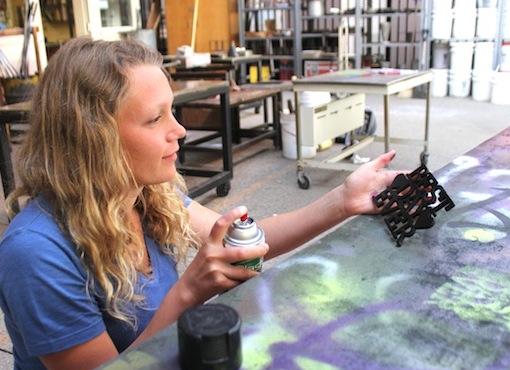
With a cup of corn syrup and potassium nitrate powder, sophomore James Wang produced fuel for his rocket. Made only of plastic pipes and a UPS shipping tube, the rocket will launch 5,000 feet into the air. In addition to gaining the sheer pleasure of launching a rocket, Wang is getting credit for this creation in his English class.
In Kirk Hinton’s English 10A and Erin Angell’s World Literature classes, students spend 45 minutes a week — 20 percent of their class time — creating self-chosen innovations.

Hinton adopted this initiative from Google’s 20% Project this year, which allots its employees 20 percent of their worktime to pursue a project outside of the scope of their job descriptions. Google’s 20% Project, whose purpose is to nurture innovation, has spawned countless success stories including Gmail and Google News.
“This project gives students freedom and control,” Hinton says. “More so in recent years, there has been a push for teachers to step away from the role of ‘sage on the stage’ — in which we deliver information to students through lecture — and into that of a ‘guide on the side,’ in which we allow students to discover and explore their own passsion, and simply help them do so.”
Wang, who is building a rocket with help from sophomore Nathan Kau, has found this proccess extremely rewarding.
“[The 20% Project] provides a unique experience where we can independently create something while being unhindered from the rigid, traditional school structure,” Wang says. “We [Kau and I] started building rockets together a while back…. Everything is made from scratch. For the fuel, we used potassium nitrate, sugar, corn syrup, red iron oxide and sulphur.”

Aside from the student’s individual enjoyment, Hinton and Angell empower their students to create a product with a lasting impact.
“The purpose is to do something for an audience that’s larger than yourself,” Angell says.
Sophomores Yael Moskowitz, Hannah Subega, Adele Bloch, and Alex Rose aim to do just that. The group is creating a photo book of smiling portraits accompanied by quotes of what makes each of those individuals happiest.
“We hope to inspire happiness and joy, and remind people of the good things in life through our love of photography,” Moskowitz says.

But no matter how extravagant the project or noble the cause, students are still graded on their writing ability — just not in the format of a conventional essay.
“I’m not going to grade someone on curing cancer,” Angell says. “Instead of formalized writing and literary analyses, the students have daily blogs and proposals. It’s less about grammar, mechanics, and structure and more about their ideas.”
In order to teach students practical skills in the classroom, Hinton and Angell require their students to write a proposal, find a mentor, create weekly blogs, write an argument essay and present their final product through a TED-style talk to the class. Students are then graded on these components, rather than the final innovation.
“The students are allowed to fail, but they have to learn something from their failure and present that to the class,” Hinton says. “Not failing just means that they’re not trying hard enough.”
However, most students haven’t had to face this anguish. According to Hinton, the projects have met their respective goals by allowing students to innovate in the classroom. Next year, Hinton and Angell hope to adapt this project to other classes as well.


